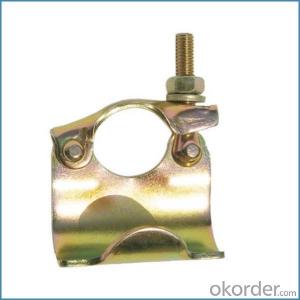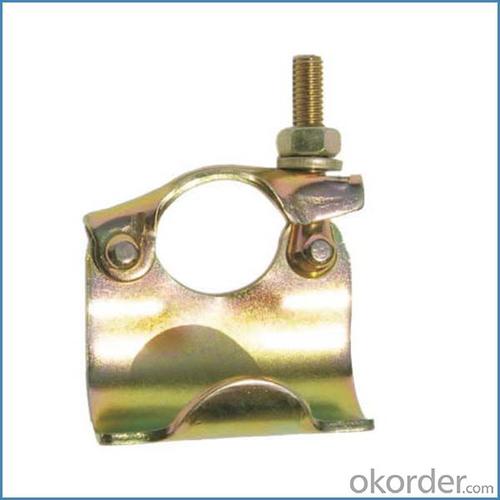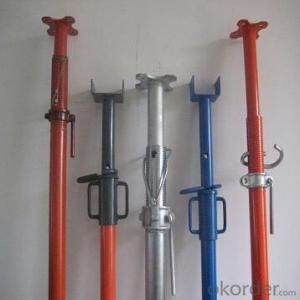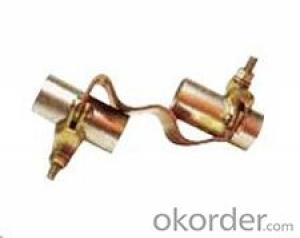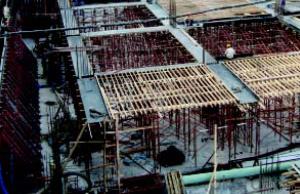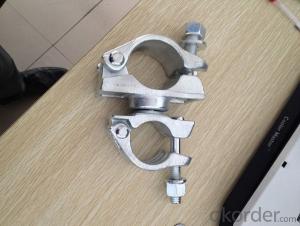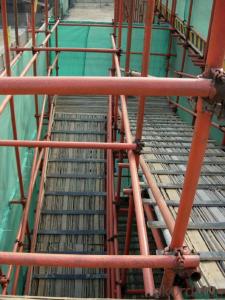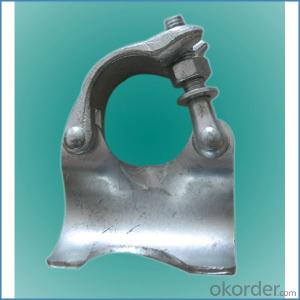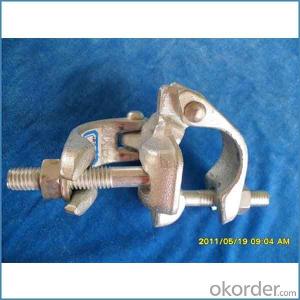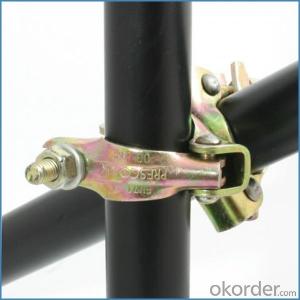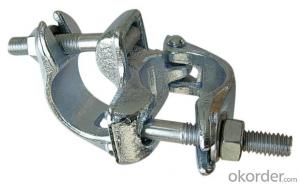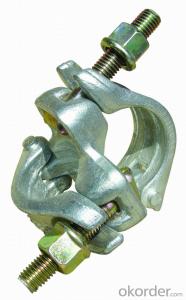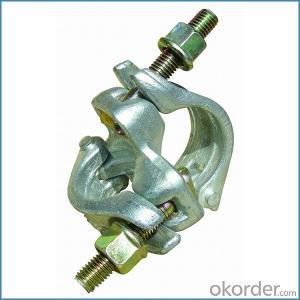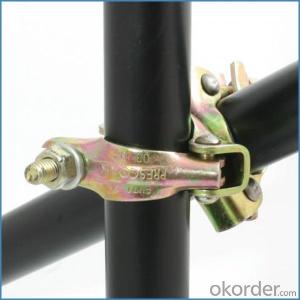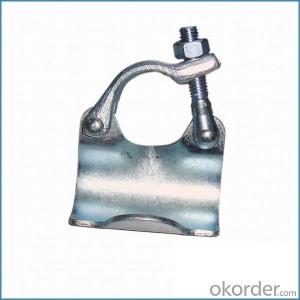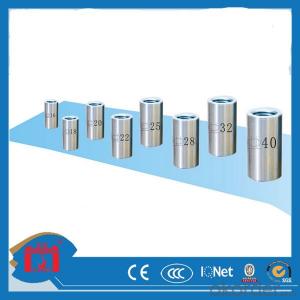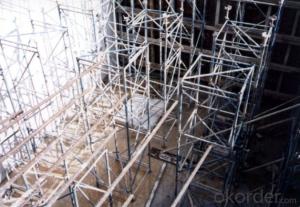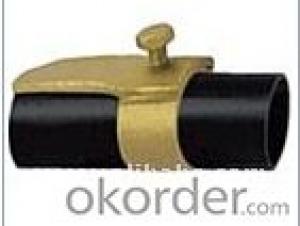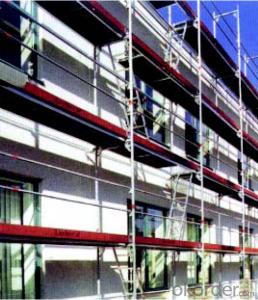Double Scaffold Clamp Britis German Forged Type
- Loading Port:
- Tianjin
- Payment Terms:
- TT OR LC
- Min Order Qty:
- 1000 kg
- Supply Capability:
- 100000 kg/month
OKorder Service Pledge
OKorder Financial Service
You Might Also Like
Double Scaffold Clamp Britis German Forged Type
Description
1.The scaffolding coupler is always used to connect the steel pipe as scaffolding system.
2.The often used coupler is swivel coupler and righ angle coupler .
3.We can provide types of scaffolding coupler according to your requirement.
4.Couoler can fix the 48.3mm scaffolding steel pipe tightly and make the whole scaffolding system more steadily.
Feature
(1)Excellent Anti-Breaking—Cold Pressed Steel
(2)Outstanding Resistance Deformation
(3)Strong Anti-Dropping Ability
Photo
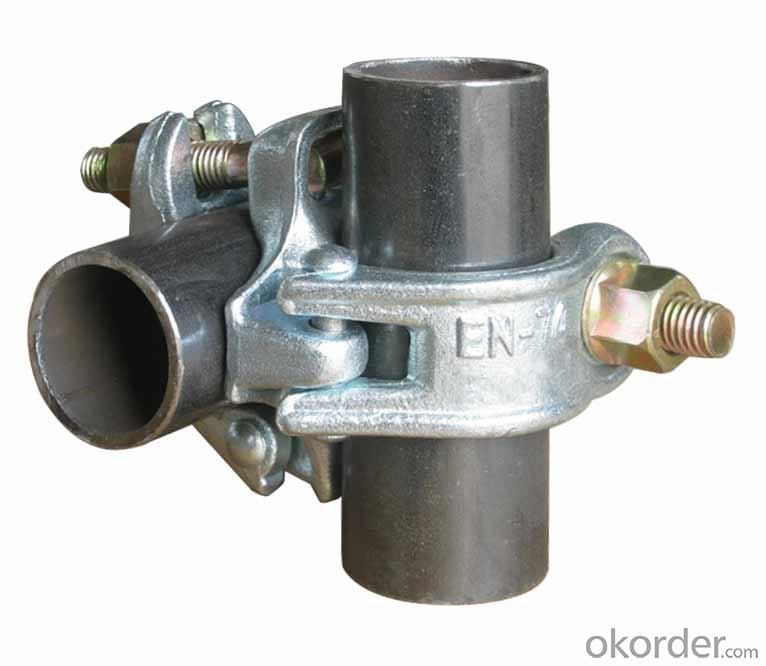
Parameter
| Material | Q235,345steel |
| Size | 48.3mm*48.3mm |
| Surface finish | Galvanized |
| Weight | 1.1kg around |
| Standard | BS1139,EN74 |
| Package | 25pcs/bag,steel pallet |
| Manufacture | As per customer requirement |
| Market | Africa, South America, the Middle East and Asia |
FAQ
Q: Are you a factory or trading company?
We are a state-owned corporation in China,dealing with various kinds of building materials.We have our holding subsidiaries.
Q: Where is your factory located? How can I visit there?
Our factory is located all around China.
Q: Can I get some samples?
Sample is free, customer only pay freight for the first time.
Q: Delivery?
10-30days. (5-15 containers)
Any question,feel free to contact us.
- Q: ... the two methods are similar
- You recommend the usual technique that's thoroughly no longer usual? :P Yeah i think of the U. S. remains caught with it, besides the incontrovertible fact that innovations like a million/2 and 3/4 are incredibly common, no longer limited to the equipment of length. :) seventy 5 centimeters = 3/4 of a meter. :)
- Q: What is the purpose of using couplers in scaffolding?
- Couplers in scaffolding serve the purpose of securely connecting different components of the scaffolding system. Typically made of steel, couplers are designed to establish a strong and dependable connection between scaffold tubes, boards, and other structural elements. With the use of couplers, scaffolding can be swiftly and effortlessly assembled and disassembled, guaranteeing stability and safety for workers on the scaffold. Furthermore, couplers allow for flexibility in configuring the scaffolding system, enabling the achievement of various angles and connections. Additionally, the use of couplers eliminates the necessity for welding or other permanent joining methods, thus enhancing the versatility and adaptability of the scaffolding system to different construction or maintenance projects. All in all, couplers play a vital role in ensuring the strength, stability, and safety of scaffolding structures.
- Q: Can steel tube couplers be used in both temporary and permanent scaffolding structures?
- Yes, steel tube couplers can be used in both temporary and permanent scaffolding structures. They provide a secure and reliable connection between tubes, ensuring the stability and strength of the scaffolding system.
- Q: Are steel tube couplers suitable for both indoor and outdoor scaffolding projects?
- Steel tube couplers are well-suited for both indoor and outdoor scaffolding projects. Due to their durability, strength, and versatility, they are widely used in scaffolding systems. The primary function of steel tube couplers is to securely connect steel tubes, thus establishing a stable scaffolding structure. In terms of outdoor projects, steel tube couplers demonstrate their ability to withstand different weather conditions. Their resistance to corrosion allows them to endure rain, wind, and other environmental factors. Moreover, steel tube couplers are designed to provide a secure connection, ensuring the safety and stability of the scaffolding structure. For indoor projects, steel tube couplers prove to be equally suitable as they are unaffected by indoor conditions such as temperature and humidity. They can be effectively utilized in various indoor applications, including construction, maintenance, and renovation projects. In summary, steel tube couplers are a reliable and versatile choice for both indoor and outdoor scaffolding projects. They establish a strong and secure connection, guaranteeing the safety and stability of the scaffolding structure in diverse environments.
- Q: Can steel tube couplers be used for scaffolding projects on uneven or unstable ground?
- When working with scaffolding on uneven or unstable ground, it is crucial to take additional steps to ensure stability and safety. The integrity of the structure may be compromised due to the challenging ground conditions. To address this issue, several measures can be implemented. Firstly, it is important to thoroughly assess the ground conditions to determine the extent of the unevenness or instability. This assessment can be carried out by a qualified engineer or an experienced scaffolding professional. Based on the assessment, appropriate actions can be taken. These may involve the use of adjustable base plates or jacks to accommodate uneven ground. These devices allow for the leveling of the scaffolding and provide a stable foundation for the structure. Furthermore, it is essential to ensure that the scaffolding is properly braced and tied to adjacent structures or supports. This will enhance overall stability and prevent any potential movement or collapse. Regular inspections should also be conducted to monitor the condition of the scaffolding and make any necessary adjustments or repairs. This will guarantee that the scaffolding remains safe and stable throughout the project. In conclusion, while steel tube couplers can be utilized for scaffolding projects on uneven or unstable ground, it is vital to take extra precautions and implement measures to ensure stability and safety. A professional assessment of the ground conditions, the use of adjustable base plates or jacks, proper bracing and tying, and regular inspections are all crucial steps to mitigate risks and maintain a secure scaffolding structure.
- Q: What are the load-bearing capacities of steel tube couplers?
- The load-bearing capacities of steel tube couplers vary depending on various factors such as the size, type, and specific design of the coupler. It is crucial to refer to the manufacturer's specifications and guidelines for accurate information on load-bearing capacities.
- Q: How long can steel tube couplers last in scaffolding applications?
- Steel tube couplers can last for several years in scaffolding applications, provided they are properly maintained, inspected regularly, and used within their recommended load capacities. However, the exact lifespan of couplers can vary depending on factors such as the quality of the couplers, the environmental conditions they are exposed to, and the frequency and intensity of their usage.
- Q: Are steel tube couplers suitable for scaffolding projects in seismic-prone areas?
- Yes, steel tube couplers are suitable for scaffolding projects in seismic-prone areas. Steel is a strong and durable material that can withstand seismic activity. Additionally, steel tube couplers provide a secure and reliable connection between scaffolding components, ensuring the stability and safety of the structure during earthquakes or other seismic events.
- Q: Are there any specific regulations or guidelines for using steel tube couplers in scaffolding?
- The use of steel tube couplers in scaffolding is subject to specific regulations and guidelines, which aim to ensure the safety and stability of the scaffold structure. These regulations and guidelines are set by national standards or codes of practice in most countries. National standards provide requirements for the design, construction, and installation of scaffolding systems that use steel tube couplers. They also offer guidance on the types of couplers that are suitable, their load-bearing capacity, and the correct methods for connecting tubes using couplers. Several important regulations and guidelines govern the use of steel tube couplers in scaffolding: 1. Load-bearing capacity: Couplers must be able to withstand the expected loads and forces exerted on the scaffold, including the weight of workers, equipment, and materials. The manufacturer should clearly indicate the load-bearing capacity of the couplers. 2. Proper installation: Couplers must be installed correctly according to the manufacturer's instructions and the relevant standards. This involves securely tightening the couplers and ensuring proper alignment and connection of the tubes. 3. Compatibility: Couplers used in the scaffolding system must be compatible with the specific type and size of tubes being used. Mixing different types or sizes of tubes and couplers could compromise the structural integrity of the scaffold. 4. Inspection and maintenance: Regular inspection and maintenance of the steel tube couplers are necessary to ensure their ongoing safety and functionality. Visual inspections should be conducted to identify any signs of damage, wear, or corrosion. Any defective couplers should be replaced immediately. 5. Training and competence: Scaffold erectors and users should receive adequate training to understand the regulations and guidelines for using steel tube couplers. They should also be able to identify and address any potential safety risks associated with coupler usage. It is important to consult the specific regulations and guidelines applicable to your jurisdiction, as they may differ. Seeking advice from a qualified engineer or scaffolding professional is recommended for specific guidance on using steel tube couplers in scaffolding.
- Q: Can steel tube couplers be used in scaffolding projects with fragile surfaces?
- Steel tube couplers can certainly be used in scaffolding projects with fragile surfaces, but extra caution and specific measures need to be taken to ensure the safety of the fragile surface. Steel tube couplers provide a secure and reliable connection between scaffold tubes, which is essential for the stability and strength of the scaffolding structure. However, since fragile surfaces are more susceptible to damage, additional steps must be taken to protect them. One approach is to use protective padding or cushions between the steel tube couplers and the fragile surface. This helps to distribute the weight and pressure evenly, reducing the risk of damage. Additionally, using larger base plates or spreader plates underneath the scaffold feet can help to further distribute the load and minimize the impact on the fragile surface. It is also important to carefully plan and design the scaffolding system to ensure that the weight is evenly distributed and that there are no concentrated loads on the fragile surface. Adequate bracing and support should be provided to maintain stability and prevent any movement or shifting that could potentially damage the surface. Regular inspections and monitoring of the scaffolding system are crucial to identifying any potential issues or signs of damage. Any signs of stress, movement, or damage should be addressed promptly to prevent further harm. Ultimately, while steel tube couplers can be used in scaffolding projects with fragile surfaces, it is essential to take additional precautions, such as using protective padding, larger base plates, and careful planning, to minimize the risk of damage and ensure the safety of the fragile surface.
Send your message to us
Double Scaffold Clamp Britis German Forged Type
- Loading Port:
- Tianjin
- Payment Terms:
- TT OR LC
- Min Order Qty:
- 1000 kg
- Supply Capability:
- 100000 kg/month
OKorder Service Pledge
OKorder Financial Service
Similar products
Hot products
Hot Searches
Related keywords
